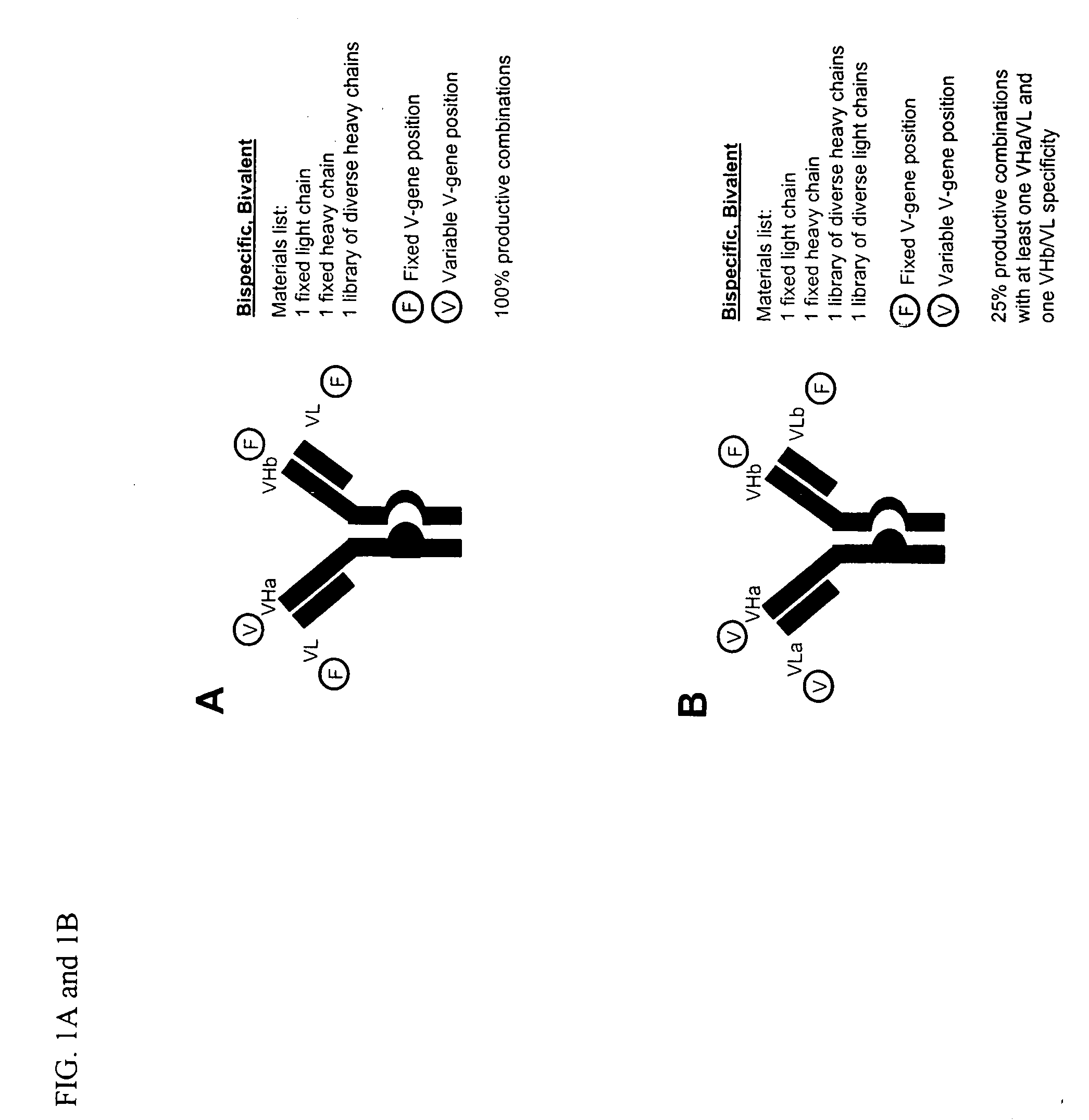Methods for producing and identifying multispecific antibodies
a multi-specific antibody and antibody technology, applied in the field of multi-specific antibody production and identification, can solve the problems of difficult assembly of many antigen binding regions, affecting the expression of bacterial hosts, and significant background binding,
- Summary
- Abstract
- Description
- Claims
- Application Information
AI Technical Summary
Benefits of technology
Problems solved by technology
Method used
Image
Examples
example 1
Construction of Human Bispecific Antibody Libraries of Diverse Specificity
[0306] Libraries of polynucleotides encoding diverse immunoglobulin subunit polypeptides are produced as follows. Genes for human VH (variable region of heavy chain), V-Kappa (variable region of kappa light chain) and V-Lambda (variable region of lambda light chains) are amplified by PCR. For each of the three variable gene families, both a recombinant plasmid library and a vaccinia virus library is constructed. The variable region genes are inserted into a pH5 / tk or p7.5 / tk-based transfer / expression plasmid between immunoglobulin leader and constant region sequences (suitably modified to comprise a heterodimerization domain or a means for tetramerization) of the corresponding heavy chain or light chain. This plasmid is employed to generate the corresponding vaccinia virus recombinants by trimolecular recombination and can also be used directly for high level expression of immunoglobulin chains following tran...
example 2
Target Cell-Based Assays to Identify Bispecific Antibodies
A. Screening for Bispecific Antibodies which Bind to the BMPR Complex
[0337] Bone homeostasis is a consequence of the balance in activities between bone formation by osteoblasts and bone resorption by osteoclasts. Osteoblasts originate from mesenchymal cells through the well coordinated interaction between growth factors called Bone Morphogenetic Proteins (BMP's) and their receptors. Signaling by BMP's is achieved through binding of BMP to a heterodimeric receptor complex comprised of a Type I and a Type II component. The BMP receptors are serine / threonine-kinase receptor members of the TGF-β receptor superfamily. BMP receptors are activated when a BMP homodimer binds to two distinct domains on the Type I and Type II receptor components. Binding then results in phosphorylation of one of the receptor components by the other and signal propagation through to the nucleus where bone-specific transcription factors become activat...
example 3
Selection of an Antibody with Defined Specificity from a Library of 109 Combinations of Immunoglobulin Heavy and Light Chains
[0350] This example is directed to defining the specific methods for producing and identifying monospecific bivalent antibodies. Based on disclosures elsewhere in this application, one of ordinary skill in the art could readily apply these methods to produce and identify bispecific antibodies, either bivalent or tetravalent. The affinity of specific antibodies that can be selected from a library is a function of the size of that library. In general, the larger the number of heavy and light chain combinations represented in the library, the greater the likelihood that a high affinity bispecific antibody is present and can be selected. Previous work employing phage display methods has suggested that for many antigens a library that includes 109 immunoglobulin heavy and light chain combinations is of a sufficient size to select a relatively high affinity specifi...
PUM
| Property | Measurement | Unit |
|---|---|---|
| Time | aaaaa | aaaaa |
| Time | aaaaa | aaaaa |
| Efficiency | aaaaa | aaaaa |
Abstract
Description
Claims
Application Information
 Login to View More
Login to View More - R&D
- Intellectual Property
- Life Sciences
- Materials
- Tech Scout
- Unparalleled Data Quality
- Higher Quality Content
- 60% Fewer Hallucinations
Browse by: Latest US Patents, China's latest patents, Technical Efficacy Thesaurus, Application Domain, Technology Topic, Popular Technical Reports.
© 2025 PatSnap. All rights reserved.Legal|Privacy policy|Modern Slavery Act Transparency Statement|Sitemap|About US| Contact US: help@patsnap.com



